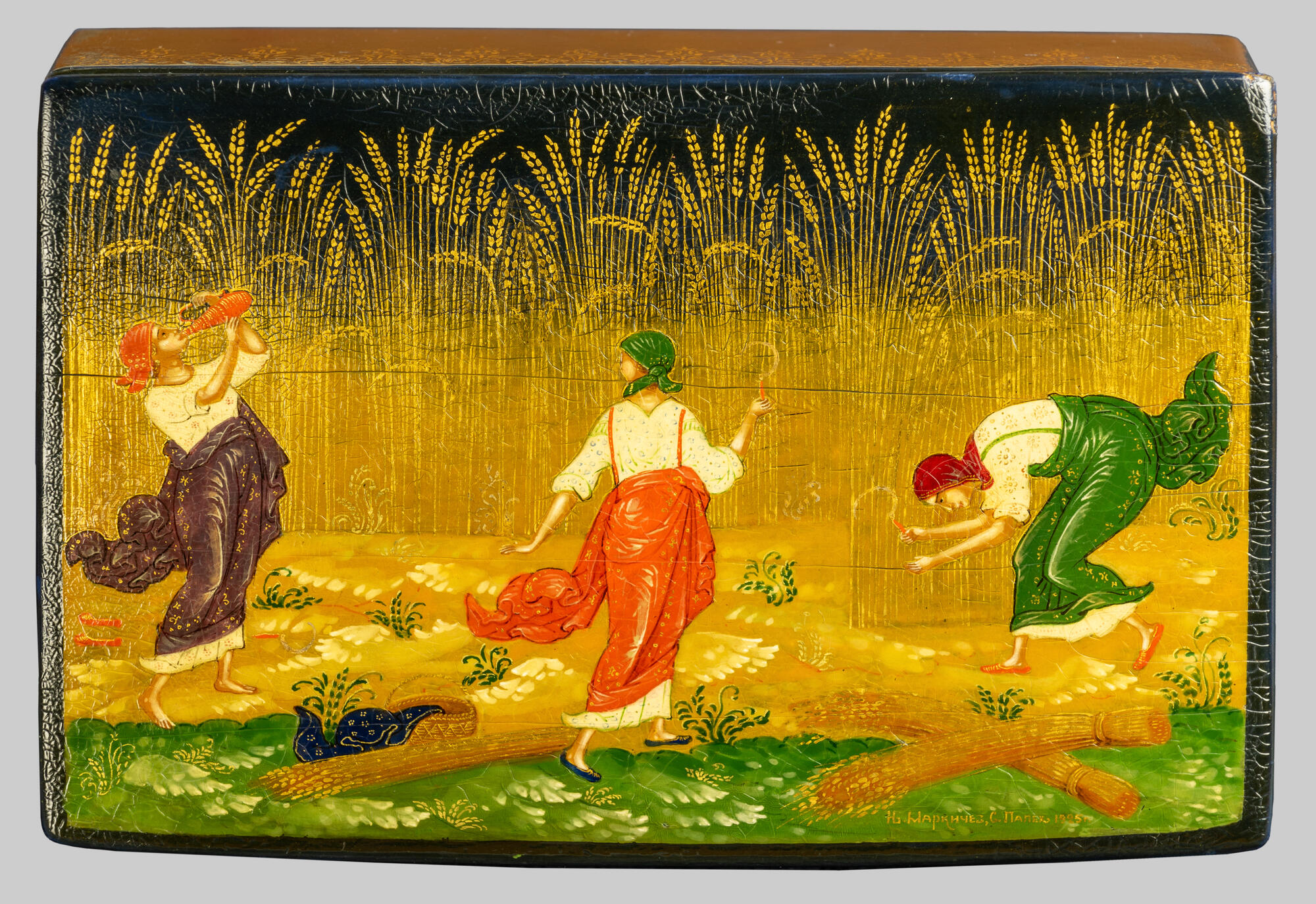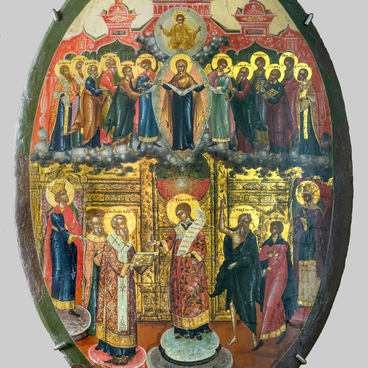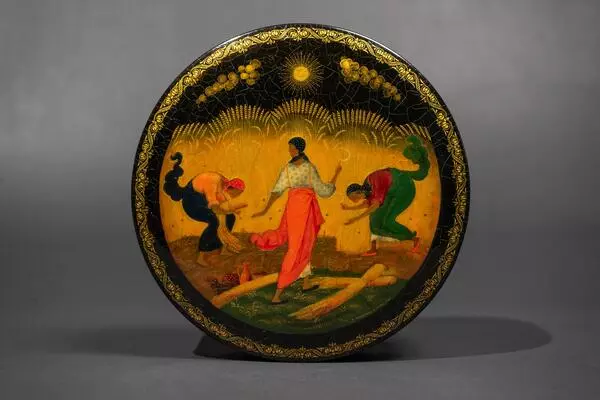Ivan Markichev painted the ‘Zhnitvo’ miniature in 1925. Here the artist addresses the theme of farmers' daily labor, demonstrating its exalted and symbolic basis.
From the depths of the black lacquer the female figures appear as soft silhouettes. They’re moving smoothly, almost dance-like. The expressive outlines merge into a single uninterrupted rhythmical pattern. These three figures, united in with wave-like motion, are the artist’s ideal of wise and gracefull Russian farmer woman. The artist did not just depict fieldwork — he depicted the eternal beauty of a woman and of Mother Earth herself.
And yet the female figures remain grounded: he showed their volumes and their connection to the earth. The artist achieved this effect using gaps: he modelled the volumes with strict light strokes, mostly strokes of color (and not gold, as the tradition would have it). The artist created the full-weight imagery of living people.
Ivan Markichev created several variants of this artwork. His simple and laconic compositions always matched the form of the object, be it a decorative plate or a rectangular casket. His unique perception of form is what makes his artworks stand out.
Ivan Markichev was born in 1883 and died in 1955. He started his career in art from painting icons; he then went on to become one of the forefathers of the Palekh lacquer miniature. Over the years of his work life, he participated in the restoration of monumental painting in the churches of Moscow, Kostroma, Yaroslavl, and at the Trinity Lavra of St. Sergius. His extensive experience in mural painting has informed the artist’s creative method. At its core it was based on the monumental arrangement of the composition.
Ivan Markichev’s artworks are majestic and rhythmically slow. They have an air of peace and calm about them. The artist does not tell captivating stories with his artworks, but rather he notes the reflections of the eternal in the common things.
Ivan Markichev had a unique approach to creating a color scheme for his miniatures. He would often start painting his compositions with open colours — he did not subdue the brightness of a given color by mixing other shades in. His color palette was based on strength and pop of individual color spots. At the same time, the artist did not strive for excessive vibrancy in his artworks, combinining the tones harmonically. This made the images look more real, and not fantastical.
From the depths of the black lacquer the female figures appear as soft silhouettes. They’re moving smoothly, almost dance-like. The expressive outlines merge into a single uninterrupted rhythmical pattern. These three figures, united in with wave-like motion, are the artist’s ideal of wise and gracefull Russian farmer woman. The artist did not just depict fieldwork — he depicted the eternal beauty of a woman and of Mother Earth herself.
And yet the female figures remain grounded: he showed their volumes and their connection to the earth. The artist achieved this effect using gaps: he modelled the volumes with strict light strokes, mostly strokes of color (and not gold, as the tradition would have it). The artist created the full-weight imagery of living people.
Ivan Markichev created several variants of this artwork. His simple and laconic compositions always matched the form of the object, be it a decorative plate or a rectangular casket. His unique perception of form is what makes his artworks stand out.
Ivan Markichev was born in 1883 and died in 1955. He started his career in art from painting icons; he then went on to become one of the forefathers of the Palekh lacquer miniature. Over the years of his work life, he participated in the restoration of monumental painting in the churches of Moscow, Kostroma, Yaroslavl, and at the Trinity Lavra of St. Sergius. His extensive experience in mural painting has informed the artist’s creative method. At its core it was based on the monumental arrangement of the composition.
Ivan Markichev’s artworks are majestic and rhythmically slow. They have an air of peace and calm about them. The artist does not tell captivating stories with his artworks, but rather he notes the reflections of the eternal in the common things.
Ivan Markichev had a unique approach to creating a color scheme for his miniatures. He would often start painting his compositions with open colours — he did not subdue the brightness of a given color by mixing other shades in. His color palette was based on strength and pop of individual color spots. At the same time, the artist did not strive for excessive vibrancy in his artworks, combinining the tones harmonically. This made the images look more real, and not fantastical.



